
Introduction
The widescreen gaming market continues to
grow as these large format screens gather in popularity. The most common sizes
available right now are 34" and 35", both with a 21:9 ultrawide aspect ratio and
nearly all modern offerings coming in a curved format. Some displays come with a
fairly low 2560 x 1080 resolution, while many others are now pushing up to the
higher 3440 x 1440 resolution. This provides a larger desktop area to work with,
smaller and sharper text and a more detailed image for gaming and multimedia; so
is generally preferred as long as you've got a system to power it. These
ultrawide screens are available based on either VA or IPS technologies, with TN
Film not breaking in to this sector yet. There's also a variety of different
refresh rate options supported, depending on the model and also on the
underlying screen resolution. Nowadays it's common for 1080p resolution models
to be pushed up to 200Hz in some cases, while the 1440p resolution models are
now common with native 100Hz refresh rates. This lower refresh rate support is
down to current bandwidth limitations of the common DisplayPort 1.2 interfaces,
not to mention what is actually supported and available from the various panel
manufacturers.
We have with us now the new Asus ROG Strix
XG35VQ, part of their Republic of Gamers brand. It's a 35" ultrawide model
featuring a VA technology panel with 3440 x 1440 resolution. It offers a 100Hz
native refresh rate, and supports AMD FreeSync for dynamic refresh rates. Asus
have also added their additional Extreme Low Motion Blur (ELMB) backlight system
to reduce motion blur in gaming, as well as some other gaming extras. We will
see how this screen compares to other 34-35" models we have tested throughout
the course of this review.
If you appreciate the review and enjoy reading and like our work, we would welcome a
donation
to the site to help us continue to make quality and detailed reviews for you.
|
Check Pricing and Buy - Direct Links
|
|
Amazon USA |
Amazon
UK |
Overclockers UK |
Amazon GER |
Amazon CAN
|
|
TFTCentral is a participant
in the Amazon Services LLC Associates Programme, an affiliate
advertising programme designed to provide a means for sites to earn
advertising fees by advertising and linking to Amazon.com, Amazon.co.uk,
Amazon.de, Amazon.ca and other Amazon stores worldwide. We also
participate in a similar scheme for Overclockers.co.uk. |

Specifications and Features
The following table gives detailed information
about the specs of the screen as advertised:
|
Monitor
Specifications |
|
Size |
35"WS
ultrawide, 1800R curve |
Panel Coating |
Light AG coating |
|
Aspect Ratio |
21:9 |
Interfaces |
1x DisplayPort
1.2, 1x HDMI 1.4, 1x HDMI 2.0
|
|
Resolution |
3440 x 1440 |
|
Pixel Pitch |
0.2382 mm, 106.55 PPI |
Design
colour |
Matt black bezel and stand
with some dark red trim in places |
|
Response Time |
4ms G2G |
Ergonomics |
Tilt, 100mm height, swivel |
|
Static Contrast Ratio |
2500:1 |
|
Dynamic Contrast Ratio |
n/a |
VESA Compatible |
Yes 100mm |
|
Brightness |
300 cd/m2 |
Accessories |
Power cable and brick. DisplayPort,
HDMI and USB cables |
|
Viewing Angles |
178 / 178 |
|
Panel Technology |
AU Optronics AMVA |
Weight |
with stand: 12.2 Kg |
|
Backlight Technology |
W-LED |
Physical Dimensions |
(WxHxD)
834.7 x (468.3 - 567.2) x 317.3 mm |
|
Colour Depth |
16.7m (8-bit) |
|
Refresh Rate |
100Hz native recommended
48 - 100Hz FreeSync range (DP and HDMI 2.0 only) |
Special
Features |
AMD FreeSync, Extreme Low
Motion Blur mode (ELMB), Aura Sync lighting, 2x USB 3.0 ports, headphone
jack, PiP / PbP options |
|
Colour Gamut |
Standard gamut, 100% sRGB |
The XG35VQ offers a reasonable range of
modern connectivity
options with 1x DisplayPort 1.2, 1x HDMI 2.0 and 1x HDMI 1.4
connections offered. The
digital interfaces are HDCP certified for encrypted content and the video cables
are provided in the box for DisplayPort and HDMI which is handy.
The screen has an external power supply and comes
packaged with the power cable and small adapter you need. There are also 2x USB 3.0 ports located on the back of
the screen with the video connections. A headphone-out connection is also provided
if you need it.
Below is a summary of the features and connections
of the screen:
|
Feature |
Yes / No |
Feature |
Yes / No |
|
Tilt adjust |
 |
DVI |
 |
|
Height adjust |
 |
HDMI |
 |
|
Swivel adjust |
 |
D-sub |
 |
|
Rotate adjust |
 |
DisplayPort |
 |
|
VESA compliant |
 |
Component |
 |
|
USB 2.0 Ports |
 |
Audio connection |
 |
|
USB 3.0 Ports |
 |
HDCP Support |
 |
|
Card Reader |
 |
MHL Support |
 |
|
Ambient Light Sensor |
 |
Integrated Speakers |
 |
|
Human Motion Sensor |
 |
PiP / PbP |
 |
|
Touch Screen |
 |
Blur Reduction Mode |
 |
|
Factory calibration |
 |
G-Sync |
 |
|
Hardware calibration |
 |
FreeSync |
 |
|
Uniformity correction |
 |
Wireless charging |
 |

Design and Ergonomics


The XG35VQ comes in an all black design with
matte plastics used for the bezel and monitor arm. There is a section of
dark red trim on the base of the stand as you can see from the provided
images. Around the edges and top the screen is a "borderless" design
(3-side) with a thin 2mm plastic edge. There is then an additional 7.5mm
black panel border, creating a total ~9.5mm edge around the top and sides.
Along the bottom edge is a thicker black plastic bezel measuring ~24mm
thickness.


The base of the stand is a sturdy and quite
heavy aluminium foot, finished in a matte black colour. It provides a wide and
sturdy base for the screen to prevent wobbling given its ultrawide format. The
screen and stand are quite deep at 317.5mm, which means that you will need a
reasonably deep desk to accommodate the screen at a comfortable viewing
position.


The back of the screen is enclosed in a matte
black plastic, finished with an etching design in places. The stand attaches as
shown above, but can be removed if you want to VESA 100 mount the display
instead. There is a useful cable tidy hole on the back of the stand as you can
see above.



Above: full tilt range shown
There is a good set of ergonomic
adjustments offered from this screen. Tilt is smooth but fairly stiff to operate,
but offers a pretty good range of adjustments as shown above.


Above: full height adjustment range shown
Height
adjustment is a little stiff too but offers smooth movements, with a
total adjustment range of 100mm measured, as advertised. At the lowest setting the bottom edge of the
screen is ~90mm from the edge of the desk, and at maximum extension is is
~190mm.
Side to side swivel is also provided and is
also a little stiff but
It provides smooth movement. Overall the stand remains very stable on
the desk with no real wobble at all when you re-position it. It's heavy and
quite chunky, but it does a very good job.
A summary of the ergonomic adjustments
are shown below:
|
Function |
Range |
Smoothness |
Ease of Use |
|
Tilt |
Yes |
Smooth |
Fairly stiff |
|
Height |
100mm |
Smooth |
Fairly stiff |
|
Swivel |
Yes |
Smooth |
Fairly stiff |
|
Rotate |
No |
- |
- |
|
Overall |
Good set of adjustments.
A little stiff to move some, although the screen is very stable and sturdy |
The materials were of a very good standard and the
build quality felt good and robust There was no audible noise from the screen,
even when conducting specific tests which can often identify buzzing issues.
The whole screen remained cool even during prolonged use as well which
was pleasing.


Above: connection options on the back of the screen
The back of the screen features the
connections. There are the 2x HDMI and 1x DisplayPort 1.2 connections offered,
along with an audio headphone output and USB upstream and 2x USB 3.0
downstream ports.

With exclusive ASUS Aura Sync lighting technology,
the ROG Strix XG35VQ provides
ambient lighting that can be synchronized with other Aura-enabled components
and peripherals.
To achieve perfect synchronization, simply connect the screen to other
peripherals by installing the Aura Sync software on your laptop or desktop.
"Enjoy the coolest and most stylish backdrop for any gaming setup, and have all
lights pulsing to the beat of your favourite music or game sound effects."

There is also the more familiar Asus "Light in Motion" light which projects
from the bottom of the stand as shown above.

OSD Menu

Above: OSD control buttons on the bottom edge of the screen
The OSD menu is controlled through a series
of 3 pressable buttons (and an additional power button at the bottom) located on
the back right hand side of the screen, as viewed from the front. Above the
buttons is a useful joystick control to quickly and easily navigate through the
sections and settings. Initially we should comment that the buttons felt a
little flimsy and plastic but they did at least work as intended.
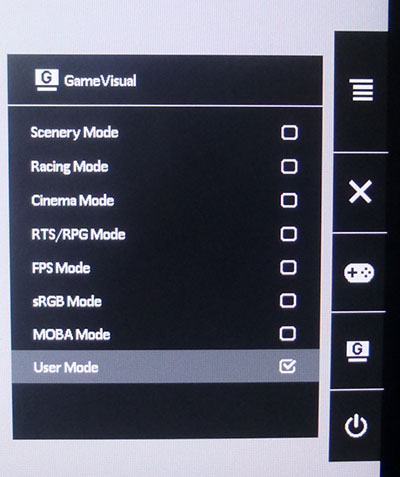
Pressing any of the buttons brings up the
quick access menu with a couple of menus available. There is quick access to the
GameVisual preset mode menu as shown above.
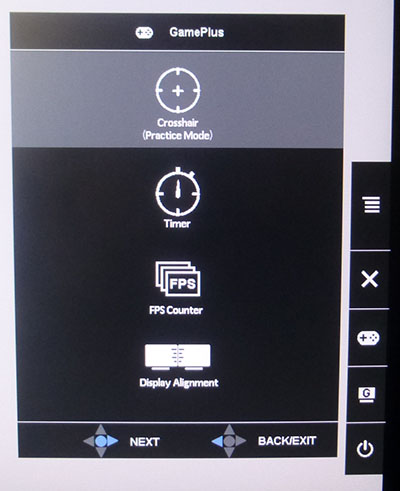
Then there is also quick access to the
GamePlus menu.
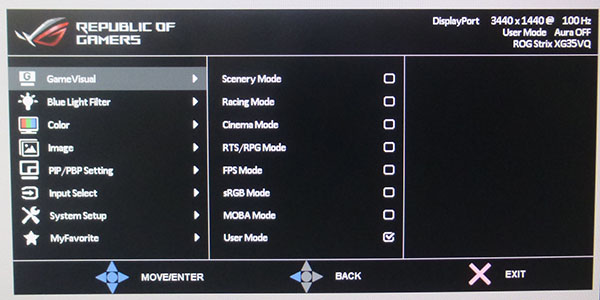
If you go in to the main OSD menu you are
presented with a much larger range of options and settings. This is split in to
8 sections down the left hand side, with options available in each then shown in
the middle area. If you drill in to an option, the actual selectable options are
then shown to the far right.
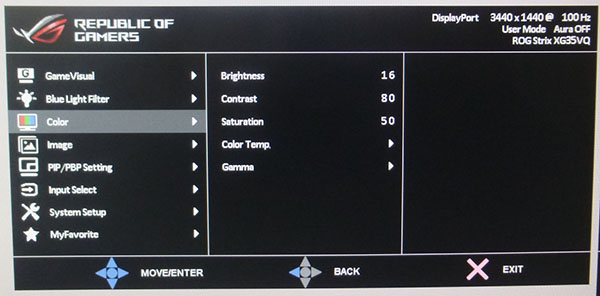
The color menu gives you control over quite a
few settings to help set the screen up and for calibration.
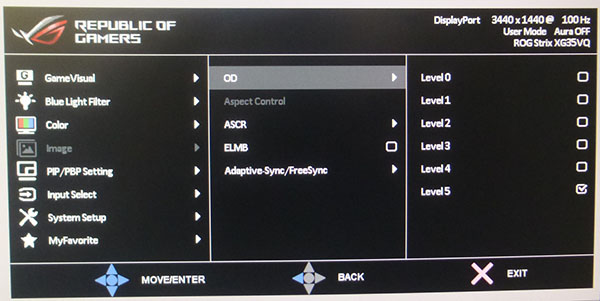
The image section also has some useful
options relating to gaming, including the overdrive (OD) control, ELMB blur
reduction mode, and the FreeSync setting.
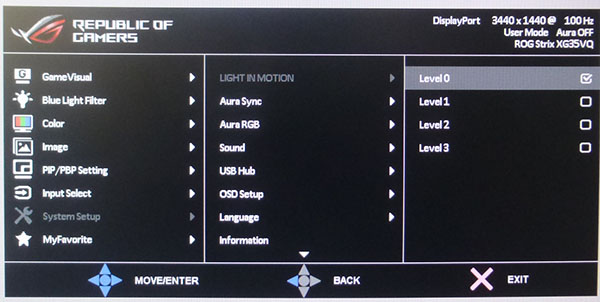
The system setup menu is shown above, with
options including the Light in Motion and Aura Sync settings.
All in all the menu provided a really good
range of options. Navigation was quick and easy thanks to the responsive
software and the joystick controller. No issues with the menu itself, just the
buttons which felt a little cheap.

Power Consumption
In terms of power consumption the
manufacturer lists typical usage of <43.0W (*measuring a screen brightness of
200 nits without audio/ USB connection), and <0.5W in standby. We carried out our normal tests to
establish its power consumption ourselves.
|
 |
|
State and Brightness
Setting |
Manufacturer Spec (W) |
Measured Power Usage
(W) |
|
Default (90%) |
<43.0 * |
61.2 |
|
Calibrated (14%) |
- |
35.3 |
|
Maximum Brightness (100%) |
- |
64.9 |
|
Minimum Brightness (0%) |
- |
30.2 |
|
Standby |
<0.5 |
0.6 |
|
Out of the
box the screen used 61.2W at the default 90% brightness setting. Once calibrated the screen reached
35.3W consumption, and in standby it
used only 0.6W. We have plotted these results below compared with other screens
we have tested. The consumption is comparable to most of the other 34" -
35" sized
screens we have tested as you might expect, with some of the smaller 25 - 27" screens
drawing slightly less power (comparing the calibrated states).


Panel and Backlighting
|
Panel Manufacturer |
AU Optronics |
Colour Palette |
16.7 million |
|
Panel Technology |
AMVA (VA-type) |
Colour Depth |
8-bit |
|
Panel Module |
M350QVR01.1 |
Colour space |
Standard Gamut |
|
Backlighting Type |
W-LED |
Colour space coverage (%) |
Quoted 100% sRGB - actual
~115% sRGB (see tests below) |
Panel Part and Colour Depth
The Asus ROG Strix XG35VQ features an
AU Optronics M350QVR01.1 AMVA (VA-type) technology panel which is capable of
producing 16.7 million colours. This is achieved through a native 8-bit colour depth.
It's the first time we have seen and tested this specific panel, although we have
reviewed the very similar M350QVR01.0 panel used in the
AOC AGON AG352UCG which has a slightly different 2000R curvature and not a borderless
design, but rest of the spec of the panel remains the same.
Screen
Coating
The
screen coating is a light anti-glare (AG) like other modern VA panels. It retains its anti-glare properties
to avoid too many unwanted reflections of a full glossy coating, but does not
produce an too grainy or dirty an image that some thicker AG coatings can.
It is not a semi-glossy coating like some older VA panels. There are some faintly visible cross-hatching patterns but nothing you should
notice during normal use unless you go looking for them very close to the
screen.
Backlight Type and Colour Gamut
The screen uses a White-LED (W-LED) backlight
unit which is standard in today's market. This helps reduce power consumption
compared with older CCFL backlight units and brings about some environmental
benefits as well. The W-LED unit offers a standard colour gamut which is
approximately equal to the sRGB colour space. Asus quote 100% sRGB coverage.
Anyone wanting to work with wider colour spaces would need to consider wide
gamut backlight screens or those which feature technologies such as Quantum Dot
for extending the colour space in to wider coverage of references like DCI-P3
and Adobe RGB. If you want to read more about colour spaces and
gamut then please have a read of our
detailed article. Remember, most content is produced in sRGB and so this
standard gamut is likely to be sufficient for most average users.
Backlight
Dimming and Flicker
We tested the screen to establish the methods used
to control backlight dimming. Our in depth article talks in more details about a
previously very common method used for this which is called
Pulse Width Modulation (PWM). This in itself gives cause for concern to some
users who have experienced eye strain, headaches and other symptoms as a result
of the flickering backlight caused by this technology. We use a photosensor +
oscilloscope system to measure backlight dimming control
with a high level of accuracy and ease. These tests allow us to establish
1) Whether PWM is being used to control the
backlight
2) The frequency and other characteristics at which this operates, if it is used
3) Whether a flicker may be introduced or potentially noticeable at certain
settings
If PWM is used for backlight dimming, the higher
the frequency, the less likely you are to see artefacts and flicker. The duty
cycle (the time for which the backlight is on) is also important and the shorter
the duty cycle, the more potential there is that you may see flicker. The other
factor which can influence flicker is the amplitude of the PWM, measuring the
difference in brightness output between the 'on' and 'off' states. Please
remember that not every user would notice a flicker from a backlight using PWM,
but it is something to be wary of. It is also a hard thing to quantify as it is
very subjective when talking about whether a user may or may not experience the
side effects.
100%
50%
0%



Above scale = 1
horizontal grid = 5ms
At all brightness settings a constant
Direct Current (DC) voltage is applied to the backlight, and the
screen is free from the obvious off/on switching of any PWM dimming method.
The screen is flicker free as advertised.
|
Pulse Width
Modulation Used |
No |
|
Cycling
Frequency |
n/a |
|
Possible
Flicker at |
|
|
100% Brightness |
No |
|
50% Brightness |
No |
|
0% Brightness |
No |

Contrast
Stability and Brightness
We wanted to see how much variance there was in
the screens contrast as we adjusted the monitor setting for brightness.
In theory, brightness and contrast are two independent parameters, and good
contrast is a requirement regardless of the brightness adjustment.
Unfortunately, such is not always the case in practice. We recorded the
screens luminance and black depth at various OSD brightness settings, and
calculated the contrast ratio from there. Graphics card settings were left at
default with no ICC profile or calibration active. Tests were made using an
X-rite i1 Display Pro colorimeter. It should be noted that we used the
BasICColor calibration software here to record these, and so luminance at
default settings may vary a little from the LaCie Blue Eye Pro report.
|
OSD
Brightness |
Luminance
(cd/m2) |
Black
Point (cd/m2) |
Contrast
Ratio
( x:1) |
|
100 |
376.24 |
0.19 |
1979 |
|
90 |
353.17 |
0.17 |
2077 |
|
80 |
325.63 |
0.16 |
2035 |
|
70 |
300.81 |
0.15 |
2005 |
|
60 |
270.24 |
0.13 |
2079 |
|
50 |
242.58 |
0.12 |
2022 |
|
40 |
213.45 |
0.11 |
1940 |
|
30 |
177.27 |
0.09 |
1970 |
|
20 |
144.42 |
0.07 |
2063 |
|
10 |
103.38 |
0.05 |
2068 |
|
0 |
65.65 |
0.03 |
2188 |
|
Total Luminance Adjustment Range
(cd/m2) |
310.59 |
Brightness OSD setting controls backlight? |
 |
|
Total Black Point
Adjustment Range (cd/m2) |
0.16 |
|
Average Static Contrast Ratio |
2039:1 |
PWM Free? |
 |
|
Recommended OSD setting
for 120 cd/m2 |
14 |
The brightness control gave us a good range
of adjustment. At the top end the maximum luminance reached 376
cd/m2
which was a lot higher than the specified maximum brightness of 300 cd/m2
from the manufacturer. This is actually good as it will help boost the potential
luminance of the strobed backlight mode we will test later on (ELMB). There was
a good 311 cd/m2 adjustment range in total, and so at the minimum
setting you could reach down to a low luminance of 66 cd/m2. This should
probably be
adequate for most people wanting to work in darkened room conditions with low
ambient light although it doesn't reach as low as some screens. A setting of 14 in the OSD menu should return you a
luminance of around 120 cd/m2 at default settings.
It should be noted
that the brightness regulation is controlled without the need for
Pulse Width Modulation for all
brightness settings so the screen is flicker free.

We have plotted the
luminance trend on the graph above. The screen behaves as it should in this
regard, with a reduction in the luminance output of the screen controlled by the
reduction in the OSD brightness setting. This is basically a linear relationship as you
can see.

The average contrast ratio of the screen
was good thanks to the VA panel, measured at 2039:1 but this left it a little shy of the specified
2500:1. It remained mostly stable across the brightness adjustment range.

Testing
Methodology
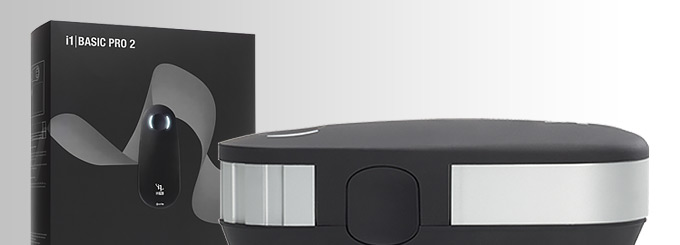
An
important thing to consider for most users is how a screen will perform out of
the box and with some basic manual adjustments. Since most users won't have
access to hardware colorimeter tools, it is important to understand how the
screen is going to perform in terms of colour accuracy for the average user.
We restored our graphics card to default settings
and disabled any previously active ICC profiles and gamma corrections. The
screen was tested at default factory settings using our new
X-rite i1
Pro 2 Spectrophotometer combined with
LaCie's Blue Eye Pro software suite. An X-rite i1 Display Pro colorimeter was
also used to verify the black point and contrast ratio since the i1 Pro 2
spectrophotometer is less
reliable at the darker end.
Targets for these tests are as follows:
-
CIE Diagram - validates the colour space
covered by the monitors backlighting in a 2D view, with the black triangle representing the
displays gamut, and other reference colour spaces shown for comparison
-
Gamma - we aim for 2.2 which is the default
for computer monitors
-
Colour temperature / white point - we aim
for 6500k which is the temperature of daylight
-
Luminance - we aim for 120
cd/m2, which is
the recommended luminance for LCD monitors in normal lighting conditions
-
Black depth - we aim
for as low as possible to maximise shadow detail and to offer us the best
contrast ratio
-
Contrast ratio - we aim
for as high as possible. Any dynamic contrast ratio controls are turned off here
if present
-
dE average / maximum -
as low as possible.
If DeltaE >3, the color displayed is significantly different from the
theoretical one, meaning that the difference will be perceptible to the
viewer.
If DeltaE <2, LaCie considers the calibration a success; there remains a
slight difference, but it is barely undetectable.
If DeltaE < 1, the color fidelity is excellent.

Default Performance and
Setup
Default settings of the screen were as follows:
Asus
ROG Strix XG35VQ
Default Settings



|

 |
|
Monitor OSD
Default Settings |
|
|
GameVisual Preset Mode |
Racing Mode |
|
Brightness |
90 |
|
Contrast |
80 |
|
Color Temp |
User Mode |
|
RGB |
100, 100, 100 |
|
Gamma |
2.2 |
|
Luminance
Measurements |
|
|
luminance (cd/m2) |
371 |
|
Black Point (cd/m2) |
0.18 |
|
Contrast Ratio |
2075:1 |
|
Colour
Space Measurements |
|
|
sRGB coverage |
114.8% |
|
DCI-P3 coverage |
84.6% |
|
Rec.2020 coverage |
60.7% |
|
Initially out of the box the screen was set
with a high 90% brightness and so was too bright and uncomfortable to use, so you will
definitely need to turn that down. The colours felt bright and well balanced and
you could tell the screen was using a standard gamut backlight with a typical
sRGB colour space produced.
We went
ahead and measured the default state with the i1 Pro 2. The
CIE diagram
on the left of the image confirms that the monitors colour gamut (black
triangle) extends a little beyond the sRGB colour space (orange triangle). There is some minor over-coverage in
most shades,
but nothing major. We measured using ChromaPure software a
114.8% sRGB gamut coverage so that met the spec of 100% nicely, and extended a
reasonable amount
beyond that even. This measured colour space coverage corresponds to 84.6% of
the DCI-P3 reference and 60.7% of the Rec.2020 reference. This screen is not
using any Quantum Dot coating or anything to specifically boost the colour
space, as those methods normally result in around 125% sRGB coverage in order to
meet around 90 - 95% of the DCI-P3 reference for
HDR content. However, the W-LED
backlight unit here does offer a small boost in colours to 114% sRGB which helps
them look bright and a little more vivid. We tested the sRGB preset mode in the
menu in case that emulated a closer sRGB coverage but it did not make any
difference.
Default gamma was recorded at a slightly high
2.3 average,
leaving it with a small 4% deviance
from the target. The OSD menu includes two other gamma settings which we
measured. The 1.8 setting resulted in a measured 1.9 gamma average, while the
2.5 setting measured in at 2.6 average. We will stick with the default 2.2
option in the OSD menu to deliver a gamma closest to our target for general use. White
point was measured at a slightly cool 6801k which left it a small 5%
out from the 6500k we'd ideally want for desktop use. There are a range of other
colour temp presets available in the menu along with a user configurable 'Custom
Color' mode
where you have access to the individual RGB channels for the
calibration
process.
Luminance was recorded at a very bright 371
cd/m2
which is too high for prolonged general use, you will likely need to turn
that down. The screen was set at a default
90% brightness in the OSD menu but that is easy to change of course to reach a
more comfortable setting without impacting any other aspect of the setup. The
black depth was 0.18 cd/m2 at this default
maximum brightness setting, giving us a strong static contrast ratio of
2075:1 thanks to the VA panel, although a little lower than the specified 2500:1 figure
from the manufacturer.
Colour accuracy was good out of the box
with an average dE of 1.8, and a max of 3.3. Testing the screen with colour
gradients showed fairly smooth gradients with some slight gradation evident in
the darker
tones. There was no sign of any colour banding which was good news. All in all a
pretty decent factory setup to be honest which should suit most users without
much need for calibration devices. A few minor tweaks to the OSD RGB controls
and certainly the brightness setting should do the trick.

Calibration
We used the
X-rite i1 Pro 2
Spectrophotometer combined with the LaCie Blue Eye Pro software package to
achieve these results and reports. An X-rite i1 Display Pro colorimeter was used
to validate the black depth and contrast ratios due to lower end limitations of
the i1 Pro device.
|
|

 |
|
Monitor OSD
Default Settings |
|
|
GameVisual Preset Mode |
User Mode |
|
Brightness |
14 |
|
Contrast |
80 |
|
Color Temp |
User Mode |
|
RGB |
100, 98, 95 |
|
Gamma |
2.2 |
|
Luminance
Measurements |
|
|
luminance (cd/m2) |
120 |
|
Black Point (cd/m2) |
0.06 |
|
Contrast Ratio |
1938:1 |
|
Colour
Space Measurements |
|
|
sRGB coverage |
115.8% |
|
DCI-P3 coverage |
85.3% |
|
Rec.2020 coverage |
61.2% |
|
We first of all switched to the 'Custom
Color' preset mode which gives you access to adjust the RGB channels
individually. When you first switch to this mode the screen is quite noticeably
warmer than the 'Standard' preset, so we know we will need to bring down the red
channel at least. We adjusted the RGB
channels and brightness setting as shown in the table above as part of the
guided calibration process. These OSD
changes allowed us to obtain an optimal hardware starting point and setup before software level changes would be
made at the graphics card level. We left the LaCie software to calibrate
to "max" brightness which would just retain the luminance of whatever brightness
we'd set the screen to, and would not in any way try and alter the luminance at
the graphics card level, which can reduce contrast ratio. These adjustments
before profiling the screen would help preserve tonal values and limit
banding issues. After this we let the software carry out the LUT adjustments and create an
ICC profile.
Average gamma was corrected now nicely to 2.2
average which fixed the small 4% deviance we'd seen out of the box. The
additional small 5% white point deviance had now been corrected bringing the measured
white point to 6530k. Luminance had been improved thanks to the adjustment to
the brightness control and was now being measured at a far more comfortable 120
cd/m2.
This left us a black depth of 0.06 cd/m2 and a static
contrast ratio of 1938:1. This was slightly lower than default (2075:1) as we had
made some minor changes to the RGB levels and then to the gamma curve at the graphics card level to correct
the small variations. Colour accuracy of the resulting
profile was excellent, with dE average of 0.6 and maximum of 1.1. LaCie would
consider colour fidelity to be excellent.
Testing the screen with various colour
gradients showed mostly smooth transitions with only some minor gradation in
darker tones. There was a little added banding in medium dark shades which was
caused by adjustments to the
graphics card LUT from the profiling of the screen to correct the gamma curve.
You can use our settings and
try our calibrated ICC profile if you wish, which are available in
our ICC profile database. Keep in mind that results will vary from one
screen to another and from one computer / graphics card to another.

Calibration Performance Comparisons

The comparisons made in this section try to give
you a better view of how each screen performs, particularly out of the box which
is what is going to matter to most consumers. We have divided the table up by
panel technology as well to make it easier to compare similar models. When comparing the default factory
settings for each monitor it is important to take into account several
measurement areas - gamma, white point and colour accuracy. There's no point
having a low dE colour accuracy figure if the gamma curve is way off for
instance. A good factory calibration requires all 3 to be well set up. We have
deliberately not included luminance in this comparison since this is normally
far too high by default on every screen. However, that is very easily controlled
through the brightness setting (on most screens) and should not impact the other
areas being measured anyway. It is easy enough to obtain a suitable luminance
for your working conditions and individual preferences, but a reliable factory
setup in gamma, white point and colour accuracy is important and some (gamma
especially) are not as easy to
change accurately without a calibration tool.
From these comparisons we can also compare the
calibrated colour accuracy, black depth and contrast ratio. After a calibration
the gamma, white point and luminance should all be at their desired targets.

Default setup of the screen out of the box
was good with only small minor deviance in the gamma curve (4%) and white point
(5%). Contrast was also strong thanks to the VA panel and there was a very good
colour accuracy with dE of only 1.8 by default. The
Acer Predator Z35 and
AOC
AGON AG352UCG are the most similar competitors and show slightly higher deviance
from these measurements. The Acer uses a different panel generation as it is
only a 2560 x 1080 resolution (but has a 200Hz refresh rate) and delivers a
higher static contrast ratio than the AOC and Asus models here, but it's default
setup is not quite as accurate in other areas. Overall no real
issues with the default setup of the XG35VQ.


The display was strong when it came to black
depth and contrast ratio thanks to the VA panel. With a calibrated contrast
ratio of 1938:1 it was a little shy of the specified 2500:1 figure, but that was
similar to what we'd seen from the AOC AGON AG352UCG as well, which had a 2500:1
spec and only reached 1944:1. The contrast ratio of the XG35VQ easily surpassed
what is possible from current TN Film and IPS technologies which was certainly a
strength of this panel tech.
|
Check Pricing and Buy - Direct Links
|
|
Amazon USA |
Amazon
UK |
Overclockers UK |
Amazon GER |
Amazon CAN
|
|
TFTCentral is a participant
in the Amazon Services LLC Associates Programme, an affiliate
advertising programme designed to provide a means for sites to earn
advertising fees by advertising and linking to Amazon.com, Amazon.co.uk,
Amazon.de, Amazon.ca and other Amazon stores worldwide. We also
participate in a similar scheme for Overclockers.co.uk. |

Viewing Angles

Above: Viewing
angles shown from front and side, and from above and below. Click for
larger image
Viewing angles of the screen were moderate.
The image behaved more like older generation VA panels than some of the modern
VA screens we've tested. From a side angle, the image became washed out and pale
in appearance as you can see. They were a little better actually than competing
models like the
AOC AGON AG352UCG from March 2017 and
Acer Predator Z35 we tested in January 2016. There was a little less washout
on the XG35VQ here than those models which was pleasing.
However the colour tone and gamma shifts were
more noticeable of course than IPS-type panels, including the 34"
Dell Alienware AW3418DW and
Acer Predator X34 as an example. Users should also be aware that the panel
exhibits the off-centre contrast shift which is inherent to the VA pixel
structure. When viewing a very dark grey font for example on a black background,
the font almost disappears when viewed head on, but gets lighter as you move
slightly to the side. This is an extreme case of course as this is a very dark
grey tone we are testing with. Lighter greys and other colours will appear a
little darker from head on than they will from a side angle, but you may well
find you lose some detail as a result. This can be particularly problematic in
dark images and where grey tone is important. It is this issue that has led to
many graphics professionals and colour enthusiasts choosing IPS panels instead,
and the manufacturers have been quick to incorporate this alternative panel
technology in their screens. We would like to make a point that for many people
this won't be an issue at all, and many may not even notice it. Remember, many
people are perfectly happy with their TN Film panels and other VA based screens.
Just something to be wary of if you are affected by this issue or are doing
colour critical work.
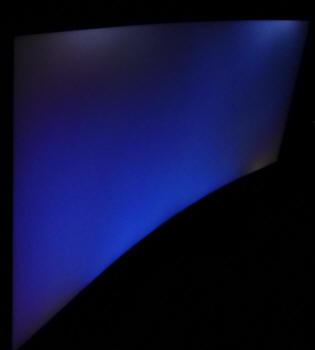
Above: View of an
all black screen from the side. Click for larger version
We captured a photo of an all-black image as
viewed from a side angle as shown above. This can help exhibit any glow you
might see on different panel technologies. Here, the actual glow caused by the
VA panel technology was quite low, with some pale areas picked up in the photo.
This side-angle photo actually captures some of the uniformity issues we
measure in the
following
section, and you can clearly see the darker and lighter areas of the screen.
From a head on viewing position this is hard to see, but viewing the screen from
a side angle accentuates it. We had seen a very similar situation on the
AOC AGON AG352UCG incidentally.

Panel Uniformity
We wanted to test
here how uniform the brightness was across the screen, as well as identify any
leakage from the backlight in dark lighting conditions. Measurements of the
luminance were taken at 35 points across the panel on a pure white background.
The measurements for luminance were taken using BasICColor's calibration
software package, combined with an X-rite i1 Display Pro colorimeter with a
central point on the screen calibrated to 120 cd/m2. The below
uniformity diagram shows the difference, as a percentage, between the
measurement recorded at each point on the screen, as compared with the central
reference point.
It is worth
noting that panel uniformity can vary from one screen to another, and can depend
on manufacturing lines, screen transport and other local factors. This is only a
guide of the uniformity of the sample screen we have for review.

Uniformity of Luminance

Uniformity of the screen was moderate. The upper area of the screen and the
left/right hand sides were darker than the central and lower regions, which
luminance dropped down to a minimum of 93 cd/m2 ( -29%
deviance). Around 64% of the screen was within a 10% variance from the
centrally calibrated 120 cd/m2 point which was average. This
variance might be problematic for colour critical work, but remember this is
a gaming orientated screen and you hopefully shouldn't really see any issues in
practice with the luminance variation.

Backlight Leakage
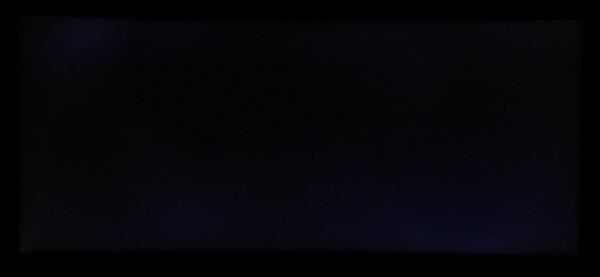
Above: All black screen in a darkened room. Click for larger version
We also tested the screen with an all black image
and in a darkened room. A camera was used to capture the result. The camera
showed there was some lighter areas along the top and bottom edges, although
from head on they were not overly noticeable. If you move to a side viewing
position these areas of bleed were quite pronounced, as you can see more clearly
in the above viewing angle
section of the review.
Note: if you want to test your own screen for
backlight bleed and uniformity problems at any point you need to ensure you have
suitable testing conditions. Set the monitor to a sensible day to day brightness
level, preferably as close to 120
cd/m2 as you can get it (our tests are
once the screen is calibrated to this luminance). Don't just take a photo at the
default brightness which is almost always far too high and not a realistic usage
condition. You need to take the photo from about 1.5 - 2m back to avoid
capturing viewing angle characteristics, especially on IPS-type panels where
off-angle glow can come in to play easily. Photos should be taken in a darkened
room at a shutter speed which captures what you see reliably and doesn't
over-expose the image. A shutter speed of 1/8 second will probably be suitable
for this.

General and Office Applications
One of the key selling points of ultra-wide
screens like the this is it's high resolution and large screen size. The 3440 x
1440 resolution offers a sharp but comfortable picture. Its pixel area is about
1.8 times larger than an Ultra-Wide Full HD 21:9 monitor (2560 x 1080), and
about 2.4 times larger than a Full HD 16:9 monitor (1920 x 1080). It provides an
efficient environment in using Microsoft Office programs showing 47 columns and
63 rows in excel. Thankfully the high resolution is of a very comfortable size
on the 35" panel, with a 0.2384mm pixel pitch is is comparable to a 27" 2560 x
1440 monitor (0.2331mm). This means you are basically getting a wider desktop to
work with, with a similar font size to a 27" model, and maintaining the same
vertical resolution as well. If you're coming from a lower resolution / larger
pixel pitch you may still find the fonts look quite small to start with, but
like the 27" 1440p models out there you soon get used to it. Side by side
multi-tasking on this screen is excellent and you really do have a nice wide
area to work with. We liked the curved format of the display actually for day to
day office work. It just felt a bit more comfortable than a flat screen on a
model as wide as this, bringing the corners a bit nearer to you. It was very
nice to have this full 3440 x 1440 resolution as opposed to the 2560 x 1080 res
we've seen on some other ultra-wide screens, including the
Acer Predator Z35. On that model, resolution was scarified in favour of a
higher refresh rate (144Hz native, 200Hz overclocked) and due to bandwidth
limitations of the current DisplayPort 1.2 standards. On the XG35VQ here, the
balance has been struck between a higher 3440 x 1440 res, and a native 100Hz
refresh rate. We definitely prefer this 1440p resolution on a screen this size.
We did feel the text was not quite as sharp
as some screens but it was hard to pin-point exactly why. It just seemed a
little more fuzzy sometimes than we were used to. It is not quite as crisp as
the 34" models due to the slightly larger pixel pitch and perhaps the
sharpness was not quite optimal either. Nothing too major, just an
observation of a minor picture clarity difference. The light AG coating of the panel is welcome,
and much better than the grainy and 'dirty' appearance of some older IPS panels
or many TN Film panel coatings. The
viewing angles of the VA panel technology were fairly typical for this
technology, and can't compete with IPS offerings. You will notice fairly obvious
contrast and colour tone shifts if you move your line of sight around much of
view the screen from an angle. Some contrast shifts may be evident because of
the very wide size of the display, as you glance towards the edges from a
centrally aligned position. That's hard to avoid on such a large desktop monitor
from close up.
The default setup of the screen was good and we were pleased with the strong
~2000:1 calibrated contrast ratio as well which is certainly a strength of the
VA panel. It might not be as high as some other VA panels which reach nearer to
3000:1, but it's still a lot better than any IPS or TN Film offering.
The
brightness range of the screen was very good, with the ability to offer a
luminance between 376 and 66 cd/m2. This should mean the screen is
perfectly useable in a wide variety of ambient light conditions, including
darkened rooms. Although it can't reach quite as low as some screens. A setting
of ~14 in the OSD brightness control should return you a luminance close to 120
cd/m2 out of the box. On another positive note, the brightness
regulation is controlled without the use of
Pulse-Width Modulation (PWM), and so those who suffer from eye fatigue or
headaches associated with flickering backlights need not worry. There are 4 low
blue light modes offered on this screen which might be useful to some users. There was no audible noise or buzzing from the screen, even
when specifically looking for it using test images with a large amount of text
at once. The screen also remains cool even during prolonged use.
There are a
few extras provided here as well including a 2x port USB 3.0 hub on the back.
There is an audio output for headphone connection if you want, and PiP / PbP
support for multiple input connections. There were no further extras such as
ambient light sensors or card readers on this model which can be useful in
office environments. There was
a decent range of ergonomic adjustments available from the stand allowing you to
obtain a comfortable position for a wide variety of angles of tilt, height and
swivel positions possible. Tilt and swivel were a little stiff to operate. The VESA mounting support may also be useful to some
people as well.

Above: photo of text at 3440 x 1440 (top) and 2560 x 1080 (bottom)
The screen is designed to run at its native
resolution of 3440 x 1440 and at a 100Hz native refresh rate. However, if you want you are able to run the screen
outside of this resolution. We tested the screen at a lower 2560 x 1080
resolution to see how the screen handles the interpolation of the resolution,
while maintaining the same aspect ratio of 21:9. At native resolution the text
was sharp and clear although as we said we did feel it felt a little fuzzy on
occasion. When running at a the lower resolution the text
becomes noticeably more blurry. You do lose a lot of screen
real-estate as well of course but it might be a more manageable resolution for
some gaming if you want to push frame rates up to the upper end of the 100Hz
support on some systems.

Responsiveness and Gaming
|
Panel Manufacturer and
Technology |
AU Optronics |
|
Panel Part |
M350QVR01.1 |
|
Quoted G2G Response Time |
4ms G2G |
|
Quoted ISO Response Time |
n/a |
|
Overdrive Used |
Yes |
|
Overdrive Control
Available Via OSD Setting |
OD |
|
Overdrive OSD Settings |
Levels 0, 1, 2, 3, 4, 5 |
|
Maximum
Refresh Rate |
100Hz |
|
Variable Refresh Rate
technology |
FreeSync |
|
Variable Refresh Rate Range
|
48 - 100Hz |
The ROG Strix XG35VQ is rated by Asus as having a
4ms G2G response time. The screen uses
overdrive / response time compensation (RTC) technology to boost pixel
transitions across grey to grey changes as with nearly all modern displays. There is a user control in the OSD menu
for the overdrive under the 'OD' setting with 6 options available -
Level 0, then Level 1, 2, 3, 4 and 5.

The part being used is the
AU Optronics M350QVR01.1 AMVA (VA-type) technology panel. This is a 100Hz
native refresh rate panel with a full 3440 x 1440 resolution supported via
DisplayPort 1.2 and HDMI 2.0 interfaces. Have a read about response
time in our
specs section if you need additional information about this measurement.
We use an
ETC M526
oscilloscope for these measurements along with a custom photosensor device.
Have a read of
our response time measurement article for a full explanation of the testing
methodology and reported data.

Response Times
60Hz Refresh Rate



First of all we tested the screen at a 60Hz
refresh rate and carried out a series of visual tests of the six OD modes. We
didn't want to take measurements in all the modes if it was unnecessary and
there was really no observable difference between Levels 1, 2 and 3 in practice.
Level 0 (the slowest) showed slightly more blurring and trailing but you had to
push the OD level up near the higher settings to make any noticeable difference.
So we start the measurements above at level 3
OD. Here you can see a lot of slow transitions, particularly on the rise times
(changes from dark to lighter shades in the upper right hand part of the table).
The 0 > 50 transition (black > dark grey) was particularly problematic and slow
at 58ms, a common issue for VA technology panels unfortunately. This dragged the
average response time figure down somewhat, so if we ignore that particularly
slow transition the average G2G response time measured in this mode was 14.3ms.
The response times here were too slow and produced a lot of noticeable blurring
and smearing on moving content. Dark trailing was particularly common because of
the slow changes from dark > lighter shades.
Pushing the OD setting up to Level 4 brought
about some small positive changes in measurements and in practice. You could see
with the naked eye that some of the dark trailing had been reduced where moving
objects were on a lighter background (more on this in a moment). However, the
image was still quite blurry and dark trailing was still a problem on darker
backgrounds for sure. Rise times were still pretty slow and the problematic 0 >
50 transition was still at 54.5ms. If we ignore that very slow transition again
there was an average 12.1ms G2G response time measured which was a bit better,
but still not exactly fast.
Moving up to the maximum Level 5 OD setting
helped reduce the response times quite a lot. If we ignore the problematic 0 >
50 transition again (still very slow!) the average G2G was now 7.7ms which was
much better. In practice moving images were clearer and sharper and blurring had
been significantly reduced. Unfortunately some fairly high levels of overshoot
were now starting to creep in, and this resulted in some pale halos on certain
colour transitions. We felt that in practice the Level 4 was probably a
preferred option, as the overshoot and pale halos introduced when using Level 5
OD were
more distracting than the additional blurring from Level 4. Ideally we would
have liked something like a Level 4.5 somewhere in the middle of these two
modes.
So for 60Hz inputs like external games
consoles or Blu-ray players for instance we would probably recommend sticking
with the Level 4 OD setting. Response times were just about fast enough overall to keep up
with the frame rate demands of 60fps, which require pixel transition times to be
<16.67ms on average.
100Hz
Refresh Rate


The ROG Strix XG35VQ can support a native
100Hz refresh rate, so we tested the response time behaviour again at this
higher setting. Some visual tests allowed us to determine the two settings at
the higher end that you'd probably want to pick between, to save us measuring
every mode again.
Level 4 behaved much like it had at 60Hz,
although at this higher refresh rate there was a small improvement in the response
times. They had been reduced from an average of 12.1ms G2G (ignoring the very
slow 0 > 50 transition), down to 10.9ms here. This helped provide some
small reductions in pixel response time related blurring which coupled with the way the human eye observes LCD
refresh rates helped improve the motion clarity a bit. It's this boost in
refresh rate that really makes the difference here when it comes to perceived
motion clarity. There was no overshoot at
all in this Level 4 mode.
Pushing the OD setting up to Level 5 improved
response times again quite nicely as we had seen at 60Hz, now down to 7.2ms G2G.
A bit of overshoot started to appear on some transitions but it wasn't as high
as at the lower refresh rate, and so in practice was less noticeable. Level 4 is
a bit slow to really handle the 100fps requirements (which needs pixel
transitions <10ms consistently) so we would recommend using Level 5 if you are
reaching those higher refresh rates up to 100Hz in your applications and games.
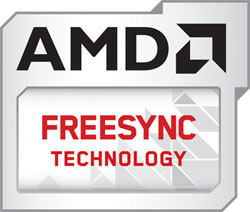
The screen supports AMD FreeSync as well for
dynamic refresh rates. This controls a refresh range between 48 and 100Hz.
We would recommend sticking with a Level 4 OD response time setting if you are
achieving refresh rates in the lower range from 48 - 80Hz or so, as this will
help avoid the pale halos from the overshoot caused by moving up to Level 5.
Keep in mind the high 3440 x 1440 refresh rate is also a drain on your system
resources here. If you are managing to achieve refresh rates in the upper 80 -
100Hz range then you will probably want to switch up to the Level 5 OD mode
which reduces some of the blurring and improves response times nicely, and
at this higher refresh rate range doesn't introduce too much noticeable
overshoot. There is some, but we didn't find it too distracting in practice.

Detailed Response Time Measurements
Refresh Rate = 100Hz, OD mode = Level 5
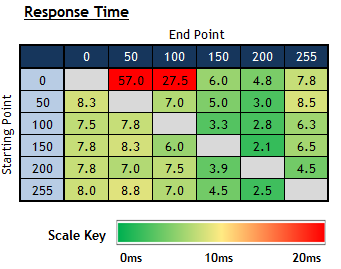
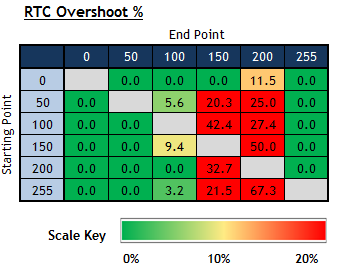
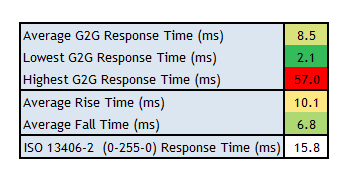
We stuck with what was the optimal 'Level 5'
OD setting and maximum 100Hz refresh rate. The
average G2G response time was measured at 8.5ms overall, but 6.1ms if you
ignore the couple of very slow problematic transitions from black to dark grey. On
the most part then, the transitions were fast enough to keep up with the frame
rate demands, where they need to be consistently under 10ms to support the 100Hz
refresh rate. However, with a few being much slower, changes from black to dark grey
shades are an issue and will introduce blurring and smearing with dark colours.
This was slightly less of a problem than on the similar
AOC AGON AG352UCQ (35", VA at 100Hz with same resolution) and
Acer Predator Z35 (35" VA at 200Hz max overclocked refresh rate but with
1080p resolution) which both had slow rise times for other black > lighter grey
transitions as well. So here, on the XG35VQ the black smearing was a little less
pronounced than on those other competing 35" VA screens. It was still there on
certain transitions though, and still a problem for most VA technology screens.
The lowest response time measured was 2.1ms, reaching below the
advertised 4ms G2G figure in fact.
If we evaluate the Response Time Compensation
(RTC) overshoot then the results are moderate. In practice we actually felt this
maximum Level 5 mode was fine as long as you were achieving the high refresh
rates of around 100Hz. The actual overshoot levels was higher in this mode than
we'd seen on the AOC and Acer screens set at their optimal modes, so although
the response times had been pushed a bit faster here, it was at the cost of a
bit more overshoot. As we say, we didn't find Level 5 too aggressive in motion
tests, but if you see any problematic overshoot then you will want to move down
to the Level 4 OD setting. The same goes at lower refresh rates too, as Level 5
is too aggressive then and we prefer Level 4.
We will make some more direct comparisons
against the Acer and AOC models in a moment in the
gaming comparisons section.

Motion Clarity (Pursuit Camera Tests)
We've already tested above the actual
pixel response
times and other aspects of the screen's gaming performance. We wanted to
carry out some pursuit camera tests as well to give an even more complete idea
of the performance of this screen.
Pursuit cameras are used to capture motion
blur as a user might experience it on a display. They are simply cameras which
follow the on-screen motion and are extremely accurate at measuring motion blur,
ghosting and overdrive artefacts of moving images. Since they simulate the eye
tracking motion of moving eyes, they can be useful in giving an idea of how a
moving image appears to the end user. It is the blurring caused by eye
tracking on continuously-displayed refreshes (sample-and-hold) that we are keen
to analyse with this new approach. This is not pixel persistence caused by
response times; but a different cause of display motion blur which cannot be
captured using static camera tests. Low response times do have a positive impact
on motion blur, and higher refresh rates also help reduce blurring to a degree.
It does not matter how low response times are, or how high refresh rates are,
you will still see motion blur from LCD displays under normal operation to some
extent and that is what this section is designed to measure. Further
technologies specifically designed to reduce perceived motion blur are required
to eliminate the blur seen on these type of sample-and-hold displays which we
will also look at.
We used the
Blurbusters.com Ghosting Motion Test which is designed to be used with
pursuit camera setups. The pursuit camera method is
explained at BlurBusters
as well as
covered in this research paper. We
carried out the tests at a range of refresh rates, in each of the 'response
time' settings. These UFO objects were moving horizontally at 960 pixels per second, at
a frame rate matching refresh rate of the monitor.
60Hz Refresh
Rate
Level 4
Level 5

We took some pursuit camera photos first of
all with a 60Hz refresh rate, and while using Level 4 and Level 5 OD control. We
have included the UFO test images on the three different coloured backgrounds as
this can help pick out any specific blurring issues. At 60Hz shown above you can
see that there is a fairly large amount of motion blur. This is caused by the
fairly slow response times and also the relatively low refresh rate. On the top
images where there is the darkest background you can see some noticeable dark
trailing behind the moving UFO object, which is caused by the slow rise times.
This is noticeable in practice and common to many VA technology panels. If you
push the OD setting up to the maximum Level 5 you can see some small improvements in
motion clarity, which is a little more obvious in practice than is shown here.
However you do start to see a pale halo
behind the moving object, particularly on the lighter coloured backgrounds which
was again quite noticeable in practice and probably a little more distracting
than just sticking with the slightly more blurry Level 4 setting.
100Hz
Refresh Rate
Level 4
Level 5

If you change to the 100Hz
refresh rate of the panel then there are certainly some nice improvements in
motion clarity. Blurring is considerably reduced, especially if you now use the
Level 5 OD setting. This is a result of the improved pixel response times,
combined with the nice increase in refresh rate which has a direct impact on
perceived motion blur of LCD displays. Unfortunately you can still see some
issues with black trailing and blurring on the darker backgrounds, which is due
to a few lingering very slow rise times. It was a little better at the Level 5
OD compared with Level 4, and the blurring on the lighter backgrounds was
noticeably reduced too in practice. There was only a moderate amount of overshoot
at Level 5 if you are using 100Hz so the image looked better than at the lower
refresh rates when using this OD mode. Certainly optimal if you can push up to the upper
refresh rate range on this screen and use the Level 5 OD setting we felt.
For further motion clarity
tests using the strobed backlight system see our
Extreme Low Motion Blur section in a moment as well.

Extreme Low Motion Blur (ELMB)
Many NVIDIA G-sync capable screens feature a blur reduction option called Ultra
Low Motion Blur (ULMB), which offers a strobing backlight system designed to
help reduce perceived motion blur of LCD displays. Of course the XG35VQ is an
AMD FreeSync screen instead, and so not to be out-done, Asus have created their
own Extreme Low Motion Blur (ELMB) technology. This is not linked to FreeSync
like ULMB is to G-sync, it is added separately to the screen and so in theory
could be used on any display which supports a suitable refresh rate. We've had
an in depth look at these blur reduction backlights in the past and would
recommend a read of our
detailed article if you want to know more about how they work, and what they
can offer.
We have actually yet to see a 3440 x 1440
resolution ultrawide screen feature any blur reduction backlight, including
those which are G-sync capable - as ULMB has been left off. The XG35VQ is
therefore the first 1440p resolution ultrawide model to feature a strobing backlight
which is positive news for those looking for blur reduction benefits.
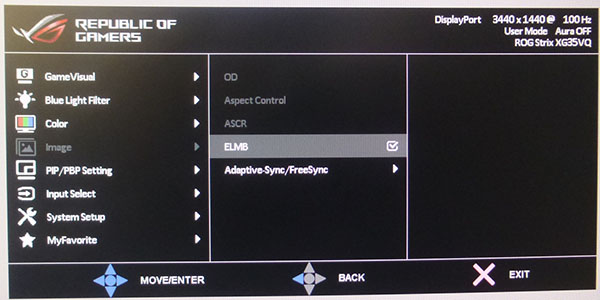
On the XG35VQ the blur reduction backlight
option is available only when running at either 100Hz or 85Hz refresh rate.
The option is not available at lower 75Hz or 60Hz modes, and also not supported
when using FreeSync. So you're not going to be able to use this feature for
external games consoles which operate at 60Hz for instance. Actually it doesn't
work when using HDMI input anyway, only with DisplayPort. When you enable it via the OSD menu the OD (overdrive)
control is also locked and not available and it's unclear which setting is
active.
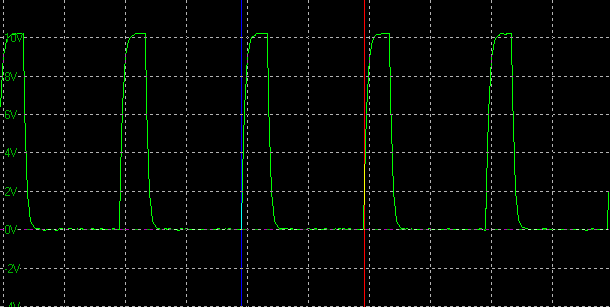
ELMB
backlight cycling, 100Hz
(scale = 5ms)
We tested the strobing ELMB backlight at both
100Hz and 85Hz settings. Above is the graph at 100Hz which shows that the
backlight is cycled on and off every 10ms in sync with the refresh rate. The
'on' period lasts 2ms, with the 'off' period lasting 8ms. A similar story at 85Hz where it is cycled on and off every 11.76ms
in sync with the refresh rate. This is normal
behaviour for these kind of backlights. There is no further control over the
strobe length or strobe timing offered on the screen, so it's just a simple
off/on strobing available here. At 85Hz we did feel that the strobing frequency
was a bit too slow and so the flicker started to become a little more obvious to
the naked eye. For maximum benefits, as long as your system can support the
res/frame rate demands, we would recommend using ELMB at the maximum 100Hz
refresh rate.
Brightness Range
|
Brightness Setting |
Luminance
(cd/m2) |
Black
Point (cd/m2) |
Contrast
Ratio
( x:1) |
|
100 |
163.78 |
0.09 |
1820 |
|
75 |
150.35 |
0.08 |
1879 |
|
50 |
134.63 |
0.07 |
1923 |
|
25 |
121.25 |
0.06 |
2021 |
|
0 |
105.28 |
0.06 |
1755 |
We also wanted to test the brightness range
available when using ELMB. The table above confirms the range
available through that control. You can achieve a slightly brighter display if
you use the feature at 85Hz since the strobes are less frequent, but it's not a significant amount.
Unfortunately the brightness setting when ELMB is
turned on is the same as when ELMB is off, so you might have to adjust the
brightness control each time you enable or disable the setting. Although you can
also save settings to one of the 'MyFavourite' modes so you could have one saved
for general use, with ELMB off and a sensible brightness level, and then another
with ELMB on and a different, higher brightness setting. You will probably
want to bump it up when you're using ELMB and thankfully there's a reasonable
range to use which is beyond some similar strobed backlight screens (see table
below). It was
higher than we'd seen from the Acer Predator Z35 for instance (111 cd/m2
maximum) which is another 35" ultrawide VA panel, but with a lower 1080p
resolution.
Maximum Blur Reduction Brightness - Display
Comparison
For ease of reference we have
also provided a comparison table below of all the blur reduction enabled
displays we've tested, showing their maximum luminance before blur reduction is
turned on (normal mode) and their maximum luminance with the feature enabled.
This will give you an idea of the maximum brightness you can expect from each
model when using their blur reduction feature, if that is important to you. A
lot of people want a brighter display for gaming and sometimes the relatively
low maximum luminance from blur reduction modes is a limitation.
These comparisons are with the refresh rate as
high as is available for the blur reduction feature to function. For most this
is at 100 - 144Hz. You can achieve a
slightly brighter display if you use the feature at compatible lower refresh
rates since the
strobes are less frequent, but it's not a significant amount. That can also
introduce more visible flicker in some situations.
|
Model |
Refresh Rate |
Max Normal
Luminance
Blur Reduction Off
(cd/m2) |
Max Luminance
Blur Reduction On
(cd/m2) |
|
Acer XB270HU* |
100Hz* |
327 |
111 |
|
Acer Predator Z35 |
120Hz |
359 |
111 |
|
Asus ROG Strix XG35VQ |
100Hz |
376 |
164 |
|
Asus ROG Swift PG258Q |
144Hz |
488 |
275 |
|
Asus ROG Swift PG278Q |
120Hz |
385 |
123 |
|
Asus ROG Swift PG279Q |
120Hz |
331 |
101 |
|
BenQ XL2720Z |
144Hz |
282 |
119 |
|
BenQ XL2730Z |
120Hz |
309 |
191 |
|
Dell S2716DG |
120Hz |
328 |
118 |
|
Eizo FG2421 |
120Hz |
386 |
257 |
|
Eizo FS2735 |
144Hz |
331 |
180 |
|
LG 34UC79G |
144Hz |
267 |
141 |
|
LG 38UC99 |
75Hz |
308 |
213 |
Note:
Pulse Width setting at max where applicable.
*Note 2: The Acer XB270HU was later updated to include a 120Hz mode, which will produce a
slightly darker maximum luminance
Blur Reduction Tests with ELMB
Of course the main thing we want to test is what
improvements the Blur Reduction mode offers when it comes to motion clarity and
gaming. We were pleased with the results we'd seen from LightBoost backlights
when we tested them, and also from the natively supported blur reduction
feature on other displays including the other popular gaming models
we've tested.
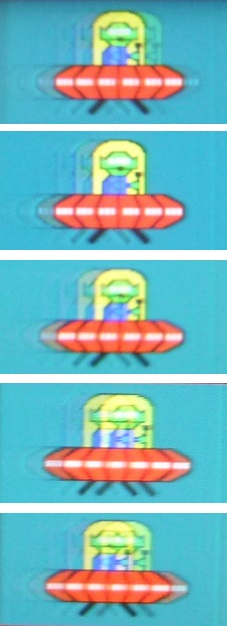
ELMB
enabled, upper, middle and lower screen areas of the screen showing cross-talk
We were a bit disappointed with the actual
motion blur reduction benefits here to be honest. We used the BlurBusters full-screen
TestUFO online motion test to put the
feature through its paces. The issue here was related to strobe cross talk and
probably also linked with some slow response times in places. The strobe cross
talk is caused by
the timing of the strobe in relation to the refresh rate, and can result in a ghost
image behind the moving object. The above results show the clearest image at the very top of the
screen. Here, the moving UFO object did become sharper and easier to track, and
motion clarity was improved quite nicely compared with standard ELMB-off motion
blur tests. However, as you moved down the screen the cross talk and ghosting
became very noticeable. It was quite bad in the middle area of the screen which
is perhaps the most important given your focus there in gaming and multimedia.
At the bottom of the screen it was really bad.
You can't eliminate strobe cross talk completely, but this could have been
tweaked better by Asus to provide a more central area of the screen with the minimal
ghosting, and cut down on some of the more extreme examples resulting at the
bottom area of the screen. Nice to see it included, and some people might like
it but we felt the ghosting produced was a little too high to be honest.

Gaming Comparisons
These comparisons were based on the optimal
Level 5 OD setting and 100HZ refresh rate.




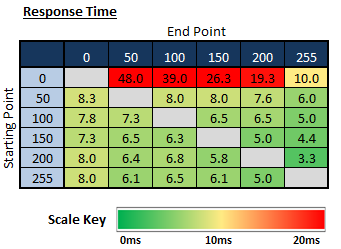
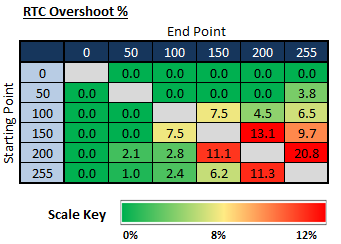
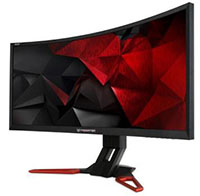

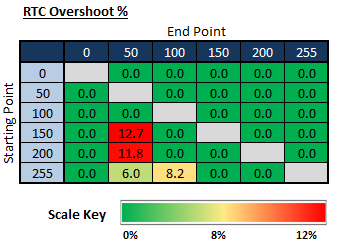
Because of the few odd slow response times on
these VA panels it is probably best to make a direct comparison at a more
detailed level, rather than just consider the average figures. We have provided
the response time and overshoot measurements of each of these 35" VA panels
above for a quicker comparison. Overall the responsiveness of the Asus was a
little better than the other two, mostly because some of the black > grey
transitions had been sorted out here. The changes to dark grey were still slow
and a problem, but at least the changes to light grey had been fixed. This
resulted in less black smearing on moving content in practice. It's not
completely eliminated, but it's a bit better than the AOC and Acer models. Yes,
there was more overshoot introduced on the Asus screen, although we didn't find
it too distracting in actual use to be honest. We suppose overall it's probably
pretty even between these models all things considered, but the difference here
really on the Asus is that it's a FreeSync screen (the others are G-sync) and
there's also the added ELMB blur reduction backlight which some may like.
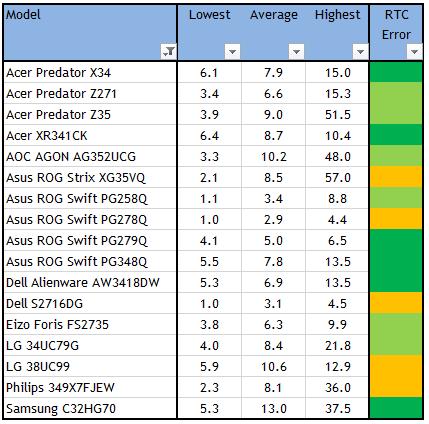
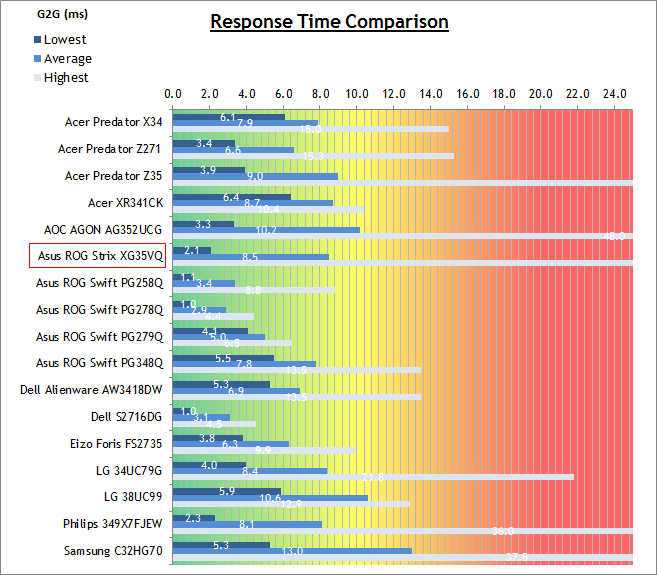
The above comparison table and graph shows you the
lowest, average and highest G2G response time measurement for each screen we
have tested with our oscilloscope system. There is also a colour coded mark next
to each screen in the table to indicate the RTC overshoot error, as the response
time figure alone doesn't tell the whole story.
High refresh rate 27" IPS models can reach a
faster than the VA offerings, with response times down to around 5ms G2G from models like the
Asus ROG Swift PG279Q
for instance (1440p res, 144Hz refresh rate). The ultrawide IPS screens like the
Dell Alienware AW3418DW (1440p res, 120Hz refresh) are also faster with a
6.9ms average. IPS panels do tend to offer better response times and freedom
from the dark trailing that you see on nearly all VA panels. You have to live
with lower contrast ratios of course, and concerns like IPS-glow but they do
offer better motion clarity and speed for gaming.

Additional Gaming Features
-
Aspect Ratio Control -
the screen has limited
hardware level
aspect ratio control
options, with only 'full' and '4:3' modes offered. It would have been useful
to include a 16:9 option for when connecting an external device which cannot
dictate the aspect ratio of the display. There's no problem for PC's where the
aspect ratio can be controlled via the graphics card, but for external devices
the lack of a 16:9 mode might be a problem.

-
Preset Modes -
There are 4 gaming preset modes
available in the menu. There are options for Racing, RTS/RPG games, FPS games
and MOBA (multi-player online battle arena) which gives you some flexibility
for different uses and will allow you to set modes up to your liking. You can
also save 4 favourite modes in the MyFavourite section which is very useful.
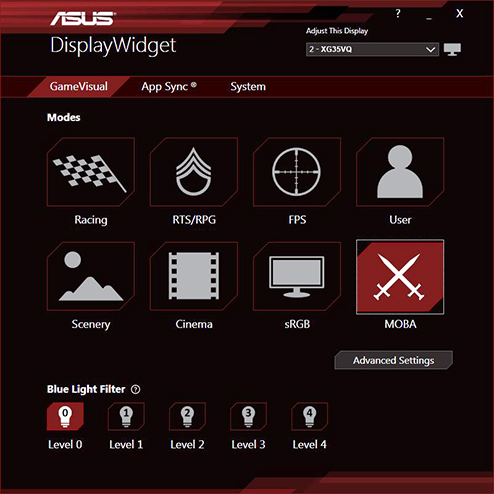
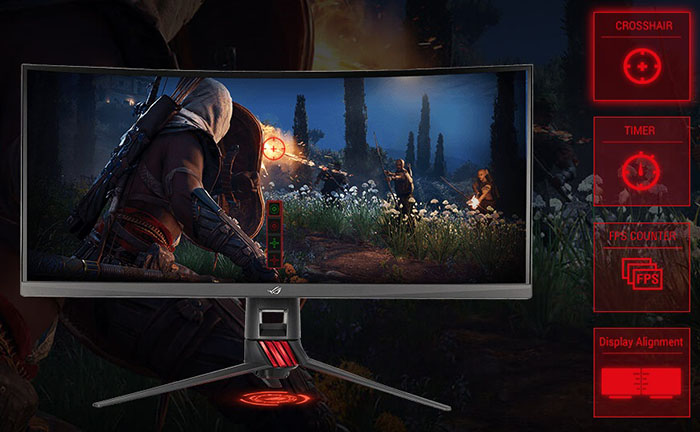
-
GamePlus settings - there are a few settings available in this menu
including an on screen cross-hair, timer, FPS counter and also the ability to
adjust the display alignment if needed. These can all be accessed via a quick
launch menu as well.

Lag
We have written an in depth article about
input lag and the various measurement techniques which are used to evaluate
this aspect of a display. It's important to first of all understand the
different methods available and also what this lag means to you as an end-user.
Input Lag vs. Display Lag vs. Signal
Processing
To avoid confusion with different terminology we
will refer to this section of our reviews as just "lag" from now on, as there
are a few different aspects to consider, and different interpretations of the
term "input lag". We will consider the following points here as much as
possible. The overall "display lag" is the first, that being the delay between
the image being shown on the TFT display and that being shown on a CRT. This is
what many people will know as input lag and originally was the measure made to
explain why the image is a little behind when using a CRT. The older stopwatch
based methods were the common way to measure this in the past, but through
advanced studies have been shown to be quite inaccurate. As a result, more
advanced tools like SMTT provide a method to measure that delay between a TFT
and CRT while removing the inaccuracies of older stopwatch methods.
In reality that lag / delay is caused by a
combination of two things - the signal processing delay caused by the TFT
electronics / scaler, and the response time of the pixels themselves. Most
"input lag" measurements over the years have always been based on the overall
display lag (signal processing + response time) and indeed the SMTT tool is
based on this visual difference between a CRT and TFT and so measures the
overall display lag. In practice the signal processing is the element which
gives the feel of lag to the user, and the response time of course can
impact blurring, and overall image quality in moving scenes. As people become
more aware of lag as a possible issue, we are of course keen to try and
understand the split between the two as much as possible to give a complete
picture.
The signal processing element within that is quite
hard to identify without extremely high end equipment and very complicated
methods. In fact the studies by Thomas Thiemann which really kicked this whole
thing off were based on equipment worth >100,1000 Euro, requiring extremely high
bandwidths and very complicated methods to trigger the correct behaviour and
accurately measure the signal processing on its own. Other techniques which are
being used since are not conducted by Thomas (he is a freelance writer) or based
on this equipment or technique, and may also be subject to other errors or
inaccuracies based on our conversations with him since. It's very hard as a
result to produce a technique which will measure just the signal processing on
its own unfortunately. Many measurement techniques are also not explained and so
it is important to try and get a picture from various sources if possible to
make an informed judgement about a display overall.
For our tests we will continue to use the SMTT
tool to measure the overall "display lag". From there we can use our
oscilloscope system to measure the response time across a wide range of grey to
grey (G2G) transitions as recorded in our
response time
tests. Since SMTT will not include the full response time within its
measurements, after speaking with Thomas further about the situation we will
subtract half of the average G2G response time from the total display lag. This should allow us to give a good estimation of
how much of the overall lag is attributable to the signal processing element on
its own.
Lag Classification
To help in this section we will also introduce a broader classification system
for these results to help categorise each screen as one of the following levels:
-
Class 1)
Less than 10ms / 1 frame lag at 100Hz - should be fine for gamers, even at high levels
-
Class
2)
A lag of 10 - 20ms / One to two frames at 100Hz - moderate lag but should be fine for many gamers.
Caution advised for serious gaming
-
Class
3)
A lag of more
than 20ms / more than 2 frames at 100Hz - Some noticeable lag in daily usage, not
suitable for high end gaming
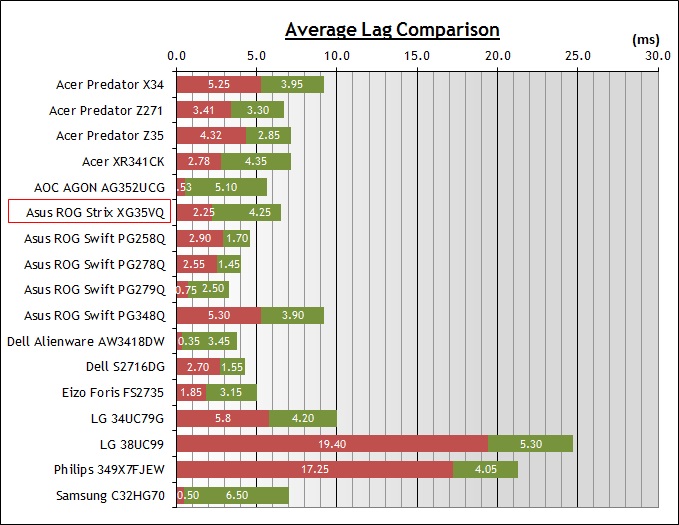
For the full reviews of the models compared here and the dates they were written
(and when screens were approximately released to the market), please see our
full
reviews index.
|
(Measurements in ms) |
|
|
Total Display Lag (SMTT
2) |
6.50 |
|
Pixel Response Time
Element |
4.25 |
|
Estimated Signal
Processing Lag |
2.25 |
|
Lag Classification |
1 |
|

Class
1 |
We have provided a comparison above against other
models we have tested to give an indication between screens. The screens
tested are split into two measurements which are
based on our overall display lag tests (using SMTT) and half the average G2G
response time, as measured by the oscilloscope. The response time is split from
the overall display lag and shown on the graph as the green bar. From there, the
signal processing (red bar) can be provided as a good estimation.
We measured a total display lag of only
6.50ms. With approximately 4.25ms of that accounted for by pixel
response times we had an estimated signal processing of only 4.25ms; next to
nothing. This was an excellent performance making the screen fully suitable for
fast gaming needs. This was a really pleasing result as often screens with
FreeSync and an additional scaler can have more moderate levels of lag. The
Philips 349X7FJEW and
LG 38UC99 for instance have 17.25ms and 19.40ms of signal processing lag.
The ROG Strix XG35VQ behaved more like a G-sync screen which typically show 1 -
5ms worth of lag, basically nothing.

Movies and Video

The following summarises the screens performance
in video applications:
-
35"
screen size makes it a good option for an all-in-one multimedia screen, but
being quite a bit smaller than most modern LCD TV's of course even at this
massive size.
-
21:9 aspect ratio is more well suited to videos, more so than the wide range of
16:9 format screens around, leaving smaller borders on DVD's and wide screen
content at the top and bottom.
-
3440 x 1440 resolution can support full 1080 HD resolution content
-
Digital interfaces support HDCP for any encrypted and protected content
-
Limited range of connectivity options provided
with 1x DisplayPort, 1x HDMI 1.4 and 1x HDMI 2.0 offered
-
Cables provided in the box
for DisplayPort and HDMI
-
Light
AG coating providing clean and clear images, without the
unwanted reflections of a glossy solution.
-
Wide brightness range adjustment possible from the display, including a
maximum luminance of ~376
cd/m2 and a fairly decent
minimum luminance of 66 cd/m2. This should afford you good control
for different lighting conditions. Brightness regulation is
controlled without the need for PWM and so is flicker free for all brightness
settings.
-
Black
depth and contrast ratio are excellent thanks to the VA panel at 1938:1 after
calibration. Detail in darker scenes should not be lost as a result and blacks
look deep.
-
There is a specific preset modes for cinema on this model which makes the
image a bit cooler than our calibrated state. Might be useful to set up for
specific movie viewing.
-
Decent
enough pixel responsiveness which should be able to handle fast moving
scenes in movies without issue. You may wish to stick with Level 4 OD given
the 60Hz refresh rate of movies (and external devices) to minimise any
overshoot. You may
experience some dark trails in places due to the slow transitions from black
to dark grey.
-
Viewing angles are a little behind what we
were hoping for and there is noticeable gamma and colour tone shift as you
change your viewing position. The image becomes quickly washed out so we
wouldn't advise using this screen for viewing from anything other than head on
really. There is at least no pale IPS-glow on dark content like you see from
the majority of IPS-type panels.
-
Some slight areas of backlight leakage but
nothing too major on our sample which is good if you're viewing from head on. Some uniformity variations may
be visible on darker movie scenes in darkened room conditions. On darker
content if you are viewing from an angle you may see areas of bleed along the
top and bottom (on our sample at least).
-
Good and generally fairly easy to use tilt, height and
swivel ergonomic adjustments available from the stand making it pretty easy to
re-position the screen for movie viewing
from a distance, or with other people.
-
No integrated stereo speakers on this model but there is a headphone output
connection if needed.
-
Limited hardware aspect ratio options with only 'full' and '4:3' offered. This may
be tricky since many external devices will operate at a 16:9 aspect ratio instead of the
screens 21:9. Not an issue when watching movies from a PC where the graphics
card can handle the scaling, but from an external device it might be an issue.
-
Picture in picture (PiP) and Picture By Picture (PbP) are also available.
-
HDR is not supported on this display.

Conclusion
The Asus ROG Strix XG35VQ was another good
offering in the ultrawide gaming space overall. There's a few VA panel options
available in the ultrawide format, although to date there haven't been many
choices with AMD FreeSync support. This was also the first screen of this format
and resolution (1440p) to feature a blur reduction backlight, so that's
currently unique to this model. Speaking of the ELMB blur reduction mode, while
it was useful to see it included and it can bring some improvements in motion
clarity, we did feel it was not set up perfectly here and so there was a fairly
high level of ghosting and strobe cross talk evident unfortunately. Pixel
response times were mostly very good, but as with most VA panels a few slow
transitions from black to dark grey drag it down a bit, and can lead to some
dark smearing in moving content. It was a little faster and better in this
regard than the other competing 35" VA models we've tested though, and something
you have to live with at the moment with VA technology for gaming in most cases.
A lot of people do prefer VA panels though as
they certainly have some strengths elsewhere. The high static contrast ratio was
an obvious benefit, achieving ~2000:1 which was much more than you'd get from
any IPS or TN Film gaming screen. The viewing angles were moderate, better than
TN Film but not as wide as IPS - although the technology is free from the pale
and white IPS-glow which some people are sensitive to. We found the default
setup of this screen good as well, and as ever it was great to see a flicker
free backlight being used. There's quite a few extra features and functions
provided with this model as well, with some high end Asus ROG design as well
which looks attractive. If you're looking for an ultrawide VA panel with AMD
FreeSync then this is a very good option right now.
If you appreciate the review and enjoy reading and like our work, we would welcome a
donation
to the site to help us continue to make quality and detailed reviews for you.
|
Pros |
Cons |
|
Fairly decent response
times on par, or slightly better than many other VA panels in this sector |
Some typical VA slow
transitions may lead to some dark smearing in some gaming |
|
Very low lag, FreeSync
support, some nice gaming extras and ELMB available for blur reduction -
unique at the moment on 1440p ultrawide screens |
ELMB not particularly
well set up so some strobe cross talk and ghosting is introduced and
fairly noticeable |
|
Decent factory setup and
high contrast thanks to VA panel |
Viewing angles are
somewhat limited compared with other competing IPS screens |
|
Check Pricing and Buy - Direct Links
|
|
Amazon USA |
Amazon
UK |
Overclockers UK |
Amazon GER |
Amazon CAN
|
|
TFTCentral is a participant
in the Amazon Services LLC Associates Programme, an affiliate
advertising programme designed to provide a means for sites to earn
advertising fees by advertising and linking to Amazon.com, Amazon.co.uk,
Amazon.de, Amazon.ca and other Amazon stores worldwide. We also
participate in a similar scheme for Overclockers.co.uk. |
|
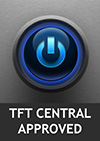
|
TFT Central Awards Explained
We have two award
classifications as part of our reviews. There's the top 'Recommended'
award, where a monitor is excellent and highly recommended by us. There is
also an 'Approved' award for a very good screen which may not be perfect,
but is still a very good display. These awards won't be given out every
time, but look out for the logo at the bottom of the conclusion. A list of
monitors which have won our awards is available
here. |